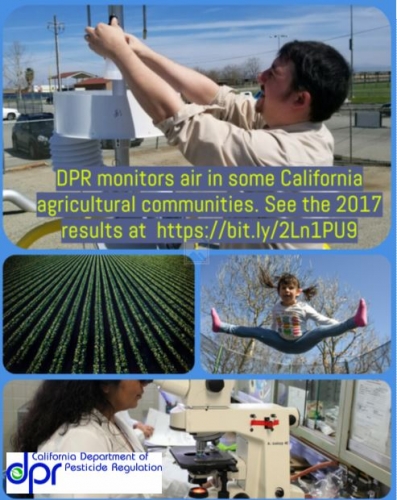From the Open-Publishing Calendar
From the Open-Publishing Newswire
Indybay Feature
DPR 2017 Air Monitoring Shows all Pesticides Below Health Screening Levels
The California Department of Pesticide Regulation (DPR) released air monitoring results showing that, once again, all of the pesticides monitored in the DPR air monitoring network in 2017, were found below levels that indicate a health concern.
However, preliminary data from a separate two-year study of the pesticide 1,3-D, a known carcinogen, shows air concentrations will require further evaluation.
"Air monitoring is an important tool that helps guide DPR in protecting human health as pesticides are applied by farmers to protect their crops from pest damage" said Brian Leahy, Director of DPR.
In 2017, DPR monitored a total of 31 pesticides and 5 pesticide breakdown products, PDF in four rural agricultural communities: Shafter (Kern County), Santa Maria (Santa Barbara County), Watsonville (Santa Cruz County), and Chualar (Monterey County). The monitoring stations are part of the DPR air monitoring network which began in 2011. It is the first of its kind in the nation, and was established to expand DPR's knowledge of the potential health risks of long-term exposure to pesticides.
California is the only state that monitors air as part of its continuous reevaluation of pesticides to ensure the protection of workers, public health and the environment.
The 2017 draft air monitoring report shows that of the 36 pesticides monitored at the 4 monitoring sites, none exceeded any screening level or regulatory targets.
Other highlights include:
9 pesticides were not detected at all and
17 pesticides were only detected at trace levels.
In addition to the monitoring mentioned above, in 2017 DPR began a 2 year air monitoring study of 1,3-D in Parlier (Fresno County) and Delhi (Merced County). 1,3-D is a pesticide that is classified as a carcinogen. It's used to fight pests that attack a wide range of crops including almonds, grapes, strawberries and sweet potatoes.
Although the air concentrations measured in Parlier did not exceed DPR's human health screening level, the 1-year average concentration would be of concern for lifetime exposure if that concentration was continuous over 70 years. Exceeding a regulatory target does not necessarily mean that an adverse health effect will occur. However, DPR will further evaluate whether the current restrictions on the pesticide's use may need to be modified to protect public health.
These findings, along with DPR's intention to replace current interim 1,3-D restrictions with a statewide regulation in the future, will be discussed at the next Scientific Pesticide Registration and Evaluation Committee (PREC) on July 20, 2018.
The meeting will be live webcast @ https://video.calepa.ca.gov/
You can read the full air monitoring report@ https://www.cdpr.ca.gov/docs/emon/airinit/air_network_results.htm
"Air monitoring is an important tool that helps guide DPR in protecting human health as pesticides are applied by farmers to protect their crops from pest damage" said Brian Leahy, Director of DPR.
In 2017, DPR monitored a total of 31 pesticides and 5 pesticide breakdown products, PDF in four rural agricultural communities: Shafter (Kern County), Santa Maria (Santa Barbara County), Watsonville (Santa Cruz County), and Chualar (Monterey County). The monitoring stations are part of the DPR air monitoring network which began in 2011. It is the first of its kind in the nation, and was established to expand DPR's knowledge of the potential health risks of long-term exposure to pesticides.
California is the only state that monitors air as part of its continuous reevaluation of pesticides to ensure the protection of workers, public health and the environment.
The 2017 draft air monitoring report shows that of the 36 pesticides monitored at the 4 monitoring sites, none exceeded any screening level or regulatory targets.
Other highlights include:
9 pesticides were not detected at all and
17 pesticides were only detected at trace levels.
In addition to the monitoring mentioned above, in 2017 DPR began a 2 year air monitoring study of 1,3-D in Parlier (Fresno County) and Delhi (Merced County). 1,3-D is a pesticide that is classified as a carcinogen. It's used to fight pests that attack a wide range of crops including almonds, grapes, strawberries and sweet potatoes.
Although the air concentrations measured in Parlier did not exceed DPR's human health screening level, the 1-year average concentration would be of concern for lifetime exposure if that concentration was continuous over 70 years. Exceeding a regulatory target does not necessarily mean that an adverse health effect will occur. However, DPR will further evaluate whether the current restrictions on the pesticide's use may need to be modified to protect public health.
These findings, along with DPR's intention to replace current interim 1,3-D restrictions with a statewide regulation in the future, will be discussed at the next Scientific Pesticide Registration and Evaluation Committee (PREC) on July 20, 2018.
The meeting will be live webcast @ https://video.calepa.ca.gov/
You can read the full air monitoring report@ https://www.cdpr.ca.gov/docs/emon/airinit/air_network_results.htm
For more information:
https://www.cdpr.ca.gov/docs/pressrls/2018...
Add Your Comments
We are 100% volunteer and depend on your participation to sustain our efforts!
Get Involved
If you'd like to help with maintaining or developing the website, contact us.
Publish
Publish your stories and upcoming events on Indybay.
Topics
More
Search Indybay's Archives
Advanced Search
►
▼
IMC Network



